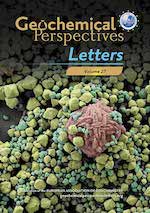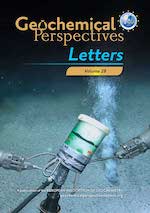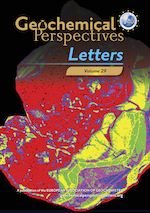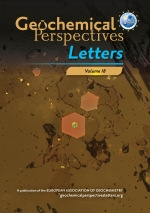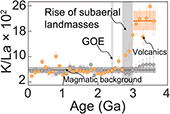 | Rise of major subaerial landmasses about 3.0 to 2.7 billion years ago Abstract: The emergence of subaerial landmasses should have inevitably modulated the chemical composition of the atmosphere-ocean and long term climate. However, it remains controversial when major subaerial landmasses first emerged in Earth’s history. Here we show that the mean K/La of globally continental mafic volcanic rocks declined from a fairly high value (∼2125) to a magmatic background (∼582, indicated by continental mafic plutonic rocks) during 3.0–2.7 Ga. It can only be explained by a progressive reduction in the proportion of submarine hydrothermally altered mafic volcanic samples and thus records a gradual rise of major subaerial landmasses from 3.0 to 2.7 Ga, likely to a present day level since 2.7 Ga. The rise and maintaining of major subaerial landmasses were intrinsically controlled by a dynamic balance of mountain building processes dominantly driven by plate tectonics and subsidence due to weathering erosion and thermal relaxation. |
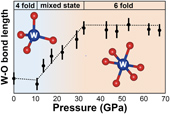 | The pressure-induced local structural change around tungsten in silicate glass Abstract: Tungsten is one of the key elements to understand the conditions and timing of planetary core formation. While the metal-silicate partitioning of tungsten has been extensively studied, the effects of pressure and silicate melt composition have been controversial. Here we have investigated the local environment of tungsten in a basaltic glass up to 67 GPa based on EXAFS spectroscopy and found that the W-O bond length increases in a pressure range from 10 to 32 GPa, indicating that W6+ ion increases the coordination number from four to six. It is known that the coordination of silicon also changes at similar pressure range, suggesting that the coordination structure of trace element tungsten may be controlled by the Si-O coordination. The coordination change of tungsten will affect its metal-silicate partitioning and may explain the previously observed change in the pressure effect around 5 GPa, when considering the difference between melt and glass. This also suggests further change in the pressure dependence above 32 GPa where tungsten is predominantly sixfold coordinated. In addition, the effect of silicate melt composition may diminish at such pressure range. |
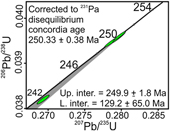 | 207Pb-excess in carbonatitic baddeleyite as the result of Pa scavenging from the melt Abstract: For the last two decades, the end of the voluminous phase of eruptions of the Siberian Traps large igneous province has been constrained by a U-Pb date of discordant baddeleyite collected from the Guli carbonatite intrusion with the assumption that the discordance resulted from unsupported 207Pb. In this study we have re-analysed baddeleyite from the same intrusion and found two types of discordance: (1) due to 207Pb-excess, and (2) radiogenic lead loss from high U mineral inclusions. The former implies that baddeleyite is an efficient scavenger of protactinium during crystallisation, leaving the magma depleted in this element. Together with a published high precision U-Pb date of 252.24 ± 0.08 Ma for the Arydzhansky Formation, our new date of 250.33 ± 0.38 Ma for the Guli carbonatite constrains the total duration of the voluminous eruptions of the Siberian Traps LIP at 1.91 ± 0.38 million years. The lower intercept of the (231Pa)/(235U) corrected discordance line yields a date of 129.2 ± 65.0 Ma, which points to the widespread Early Cretaceous rifting in East and Central Asia. |
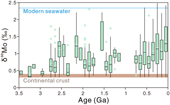 | Black shale Mo isotope record reveals dynamic ocean redox during the Mesoproterozoic Era Abstract: Eukaryotes reached ecological importance in the late Neoproterozoic Era, some one billion years after their emergence. Their slow rise to prominence has been ascribed to prolonged environmental stagnation, but testing this idea requires an appraisal of the evolution of atmospheric and ocean chemistry. Establishing a nuanced geochemical history is, however, challenging due to the paucity of well preserved sedimentary rocks. Here, we present new Mo isotope ratios from black shale units spanning ∼1560 to ∼1170 Ma. These results, combined with literature data, reveal potential episodic expansions of oxygenated and/or mildly reducing conditions during the Mesoproterozoic Era, suggesting fluctuating oxygen availability that could have exerted a crucial control on the evolution of eukaryotes. |
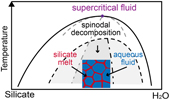 | Spinodal decomposition of supercritical fluid forms melt network in a silicate-H2O system Abstract: Supercritical fluid in silicate-H2O systems, with composition intermediate between silicate melt and aqueous fluid, has distinctive physicochemical properties and can be an important agent of mass transfer in Earth’s interior. Decreasing temperature and pressure drive supercritical fluid to a miscibility gap and cause unmixing into coexisting melt and fluid. With a hydrothermal diamond anvil cell, we observed that unmixing of a supercritical fluid with 37 to 51 wt. % aluminosilicate formed a silicate melt network, a phenomenon never documented before. The melt network was stable over a range of cooling rates, although further cooling led to disintegration of the network to dispersed melt droplets. The melt network was unlikely to be formed by nucleation-growth at discrete sites, but probably derived from an early stage of spinodal decomposition characterised by high phase interconnectivity. Also key to the stabilisation of melt network was elastic stress supported by polymerised silicate component. The occurrence of a silicate melt network with uneven fluid-melt boundaries may facilitate heterogeneous entrapment of melt and fluid. Spinodal decomposition and formation of melt network provide an efficient mechanism for fluid-melt separation and mineralisation in magmatic-hydrothermal systems. |
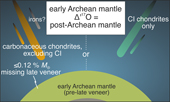 | Tight bounds on missing late veneer in early Archean peridotite from triple oxygen isotopes Abstract: Oxygen isotopes provide a unique possibility to study Earth’s late accretion phase from a lithophile element perspective, because most carbonaceous chondrites – meteorites that likely resemble the composition of the terrestrial late veneer – have markedly different Δ′17O values than the silicate Earth. Ultramafic rocks in the early Archean assemblage of southwest Greenland have not incorporated the full amount of late accreted materials, and therefore possibly record the Δ′17O of the mantle before late accretion. We measured 17O/16O and 18O/16O ratios of olivine from these ultramafic rocks and compared them with olivine from post-Archean mantle peridotite. A missing late veneer component was not resolved. The missing component from the early Archean mantle is therefore restricted to ≤0.12 % of Earth’s mass (M⊕) for most carbonaceous chondrite-like materials, unless the missing component resembles CI chondrites – the only carbonaceous chondrites with Δ′17O values similar to those of the silicate Earth. If the early Archean mantle had incorporated 60 % late veneer, the overall late accreted mass would be restricted to ≤0.3 % M⊕ for most types of carbonaceous chondrites, with a more massive late veneer only possible for CI-like chondrites. |
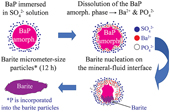 | The role of amorphous P-bearing precursors on barite formation Abstract: Past climate variations on Earth are recorded in sedimentary rocks by chemical and biological indicators. In this sense, investigations of sedimentary marine barites (BaSO4) have been fundamental to reconstruct geochemical evolution of palaeoenvironments. Despite the significant advances achieved during the past decade, the mechanism of barite formation in the ocean water column in undersaturated conditions and the role of microorganisms remain controversial. Phosphorus-rich, amorphous precursor phases have been suggested to play a key role, although the exact mechanism of marine barite formation from this precursor is not well constrained. In this paper, we evidence that barite can precipitate by replacing amorphous Ba-P precursor phases formed in the absence of living organisms. This occurs by a mineral replacement reaction, yielding an abiotic scenario for barite particles with morphologies, mesostructure and composition resembling barite formed in the marine water column. This demonstrates the need to investigate how this formation process, via the replacement of an amorphous precursor, affects the isotopic and trace element signatures of barite, and how this influences the environmental information obtained from this proxy. |
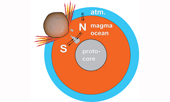 | High pressure redistribution of nitrogen and sulfur during planetary stratification Abstract: Nitrogen is essential to life, and yet is also the most depleted element in the Earth relative to gas-rich chondrites. A key expression of Earth’s N depletion is its elevated sulfur-nitrogen (S/N) ratio. Primordial stratification into a core, mantle, and atmosphere is the largest mass transfer process that terrestrial planets experience, but the data required to evaluate how S/N ratios respond to primordial stratification of Earth-sized planets do not exist. We report new metal-silicate partitioning experiments on N up to 26 GPa and 3437 K. Our data indicate that nitrogen becomes more siderophile with increasing pressure and less siderophile with increasing carbon and nickel in the metal phase. We apply our new experiments with literature data for S partitioning to a core formation-primordial atmosphere degassing model. Our model demonstrates that the S/N ratio of the observable Earth can be set during primordial stratification under the same extreme P-T conditions that satisfy refractory siderophile element budgets while also yielding a bulk planet with S contents near that estimated from Earth’s volatility trend. |
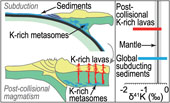 | Potassium isotope evidence for sediment recycling into the orogenic lithospheric mantle Abstract: Post-collisional highly potassic magmatism in large orogenic belts has been taken as evidence for recycling of continent-derived K-rich sediments within the orogenic lithospheric mantle. Potassium isotopes may provide important insights into the origins of K in these magmas, since subducting sediments exhibit much more variable K isotopic compositions relative to the mantle. Here we report high precision K isotope data for 41 representative potassic and ultra-potassic volcanic rocks from the whole Alpine-Himalayan orogenic belt. δ41KNIST SRM3141a of these samples vary from −1.55 ‰ to −0.32 ‰, comparable to the range of global subducting sediments but significantly exceeding the range of pristine mantle defined by oceanic basalts (−0.42 ± 0.08 ‰). Monte Carlo simulation suggests this large K isotopic range can be reproduced by recycling of up to 5 % isotopically heterogeneous sediments into the depleted mantle. Our results highlight K isotopes as a potential tracer of recycled sediments in the mantle. |
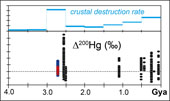 | Sulfur and mercury MIF suggest volcanic contributions to Earth’s atmosphere at 2.7 Ga Abstract: The Archean eon is associated with large-scale changes in Earth’s geosphere and biosphere, including the onset of plate tectonics and the expansion of oxygenic photosynthesis, although the full impacts of these changes on the atmosphere remain unclear. Here we present coupled records of mass independent fractionation of sulfur (S-MIF) and mercury (Hg-MIF) isotopes from well preserved sediments of the ∼2.7 billion year old (Ga) Manjeri Formation, Belingwe Greenstone Belt, Zimbabwe. These palaeoatmospheric proxies record different trends for S-MIF and odd number Hg-MIF versus even number Hg-MIF, providing novel constraints on atmospheric chemistry during this time. S-MIF and odd number Hg-MIF values are muted in comparison to values preserved in later Archean sediments, representing a combination of enhanced volcanic input and local mixing. Even number Hg-MIF is absent from these sediments, consistent with complete photo-oxidation of gaseous Hg0, which could have been driven by increased halogen emissions from arc volcanism. When considered within a global geodynamic context, these MIF data suggest an important role for subduction zone-related volcanism associated with early plate tectonics in modulating the ∼2.7 Ga atmosphere. |
<< Previous issueNext issue >>


